When hybrid cars first appeared almost 20 years ago, their main draw was that they used much less gas than other cars. They were slow, but you saved money.
This made going slow worth it.
Then gas got cheap – and electric cars got fast.
Which made spending extra for a slow hybrid a harder sell.
The latest hybrids offer a new argument: More performance, better gas mileage – and none of the practical problems of speedy but only briefly range-and-recharge-restricted electric cars.
One of them – the new Honda Accord hybrid – offers something else as well.
The 2020 Accord hybrid is the most powerful – and lowest-priced – mid-sized hybrid sedan on the market.
It is almost Prius-sippy but not as gimpy.
And you can pick one up for $25,470 to start – just $1,690 more than the base price of the non-hybrid Accord ($23,780).
Which will cost you more to gas up – while going slower.
And not nearly as far.
The Accord hybrid also has a much lower sticker price than its main rival, the hybrid version of the Toyota Camry sedan, which lists for $28,250 to start.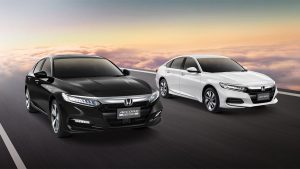
Which is about the same as an Accord EX ($29,370) with 17-inch wheels, a sunroof, an upgraded HD stereo with eight speakers, AppleCarPlay/Android Auto and an eight-inch LCD touchscreen. The almost-the-same-price Camry LE comes standard with 16 inch wheels, a six-speaker stereo and a seven-inch touchscreen.
There is a wild card pending, however – the not-yet-here hybrid version of the 2020 Hyundai Sonata.
We’ll know more by spring.
What’s New
One problem that all hybrids – and electric cars – still have is silent running. Well, it can be a problem for oblivious pedestrians in the vicinity of a moving and silent-running hybrid or electric car who step in front of one while pecking at dey sail fawn.
To avoid this, Honda has added an exterior chime system to alert oblivious pedestrians to the Accord hybrid’s presence when it’s operating in EV mode.
Which is a shame – because silent running used to be a particularly cool thing about hybrids and electric cars.
It reminds one of the early days of the automobile – when there was a requirement that a man waving red flags precede the car, to announce its impending arrival.
What’s Good
Makes economic sense.
Makes practical sense.
Makes emotional sense.
What’s Not So Good
Standard stereo in base trim has just four speakers – and you can’t buy a better one a la carte.
You can’t buy anything a la carte – without buying one of the higher-priced trims.
Driver “assistance” tech isn’t optional.
All trims come standard with a 2.0 liter four cylinder engine paired up with a lithium-ion battery pack and two electric motors, the combo generating a combined output of 212 horsepower and 232 ft.-lbs. of torque at zero RPM.
The non-hybrid Accord comes standard with a much-smaller 1.5 liter engine, no electric motors or batteries, 192 horsepower – and 192 ft.-lbs. of torque at 1,600 RPM.
It doesn’t launch as hard – or go as fast. The hybrid can do a burnout. The non-hybrid can’t, unless you power brake it.
It also uses much more gas – especially in low-speed city driving, where the hybrid has an 18 MPG advantage: 48 MPG vs. 30 MPG.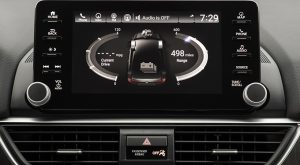
And on the highway, the hybrid still manages 47 MPG – 10 MPG better than the non-hybrid 1.5 liter Accord’s 38 MPG highway rating.
If you do a lot of stop-and-go driving, the hybrid’s much lower fuel consumption could earn back the $1,690 extra you spent on the hybrid in just a couple of years and after that, the savings could be significant.
Especially if gas prices go up – which seems more likely now not because of shortages but because another war in the Middle East is. The last time things got hot we were paying $3 for a gallon of regular unleaded.
But even if the cost of gas stays low, there’s one way the hybrid Accord will almost certainly save you money: By not forcing you to buy a replacement battery. At least, not as soon as you would probably need to if you bought an electric car.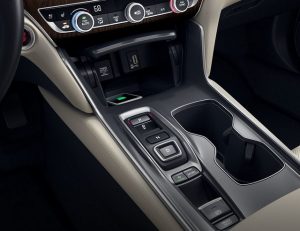
The reason being the hybrid’s battery doesn’t have to work as hard – because it only works part-time. It also never gets drained – because it is constantly and automatically being topped off by the gas engine. You can’t forget to recharge it – or run it to nearly nil charge – as can happen in an electric car driven to the hairy edge of is maximum range, which leaves it with almost no charge remaining.
Heavy discharge/recharge cycling is to electric car batteries what constantly flooring the gas pedal is to IC engines.
And even if it eventually becomes necessary to replace the Accord’s battery pack, it will cost you a lot less than it would to replace an electric car’s battery pack – because it is a smaller battery pack.
Unlike an electric car with a croaked battery – which is a bricked electric car – you can still drive a hybrid with a sick or even croaked battery. Because it still has an engine. You probably won’t get 48 MPG. Or get to 60 in 7.2 seconds, as the Accord hybrid does when its battery is healthy.
But you won’t be walking.
One other electric expense you will definitely not have is the cost of paying an electrician to wire up your house for a “fast” charger, in order to wait only 30-45 minutes for to get back on the road rather than overnight.
For EV buyers, that’s another $800-$1,000 or so not listed on the window sticker. But which is an unavoidable expense – if you don’t want to wait overnight to get going again.
The hybrid Accord is not only quick, it doesn’t stop. At least, it doesn’t stop as often – or for as long – as an electric car.
A Tesla Model 3 (which costs $15k more to start) only goes about 250 miles before it needs to be recharged, which requires stopping – and waiting – for at least 30-45 minutes, assuming you have access to a “fast” charger. You may have one at home – but how about where you’re headed – or on the way there?
If not, the wait will be much longer. Especially if there’s another electric car ahead of you in line.
This is the main practical problem with electric cars.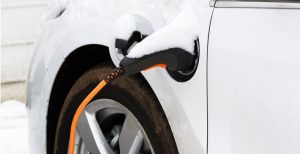
It’s no problem with a hybrid car.
The Accord hybrid isn’t tethered to a plug – because it carries its own source of electricity. The gas engine provides generating as well as motive power. You only have to stop when you run low on gas – which happens very infrequently. The Accord hybrid can travel 600 miles in between fill-ups – whether you’re driving in the city or on the highway.
The longest-range electric cars available can only travel about half as far – and they make you wait literally five times as long (at least) to recharge.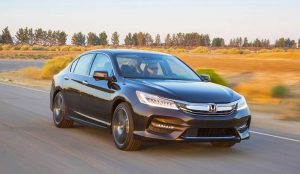
Having the ability too “toggle” in between electric and gas – and in-between – makes hybrids much more practical than electric cars while also being much more fuel-efficient than any non-hybrid car that isn’t a diesel-powered car. Those have been fatwa’d off the road – probably because they make electric cars look so . . . ludicrous.
Hybrids also make electric cars look ludicrous – which is why they’re probably going to be fatwa’d off the road, too.
Speaking of ludicrous things.
Unlike electric cars, hybrid cars like the Accord aren’t affected much by cold (or hot) weather. An electric car is – because batteries droop when it’s very cold – and drain faster when high-draw electrically powered accessories such as the heater are used.
This can result in a 30-50 percent decrease in the electric car’s real-world range.
The Accord hybrid heats for free – by using the warmth generated by the engine. And while running the AC in summer might use a bit more gas it has little effect on range and no effect on refueling times.
Of course, efficiency – and practicality – aren’t everything. Especially when gas is cheap.
The Accord hybrid gets to 60 in 7.2 seconds – not quite Ludicrous Speed, but much quicker than a Prius, which needs almost ten seconds to heave itself to the same speed. Without much MPG gain. The Prius rates 54 city, 50 highway – which isn’t tremendous compensation for all that absent acceleration.
It’s also not that far off the pace of the non-hybrid Accord with its optional 2.0 liter, 252 horsepower turbocharged engine. It gets to 60 about two seconds faster, but the point is the hybrid’s not slow in comparison.
Unlike the Prius. Which is.
The Accord hybrid is not a dedicated hybrid – like the Prius. Honda adapted a hybrid drivetrain to the Accord – which was designed as a conventional car that was converted into a hybrid.
With the result being a hybrid that doesn’t look like one.
Outside – or in.
It has the same sleek rather than geek bodywork as the regular Accord and – other than a hybrid specific instrument cluster – it has the same business class rather than computer lab interior.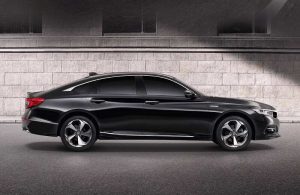
Unlike the Prius.
Which everyone knows is a hybrid because it practically announces it from built in speakers and flashes neon signs to alert the deaf.
But not everyone wants to preen green . . . while going slow.
The Prius is also a hatchback – and a compact. It has more a bit room for cargo (24.6 cubic feet) but much less room for legs in the second row. Seven inches less (33.4 inches vs. 40.4 in the Accord).
The Accord hybrid also has two inches more backseat legroom than its direct rival, the Camry hybrid – and the largest trunk (16.7 cubic feet) in the class. Its capacity is actually about 80 percent of the hatchback Prius’ capacity.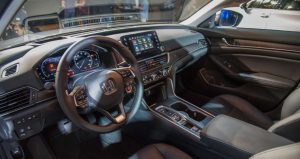
One thing the Accord has less of – if you buy the base trim – is options. There aren’t any. It comes as it is – which is decently equipped, except for one thing. You’ll have to make do with a mediocre four-speaker stereo without AppleCarPlay or Android Auto.
Eight (and ten) speaker HD stereos with AppleCarPLay, Android Auto and Sirius/XM come standard in higher trims, but these come with a much higher sticker price.
The next-up EX starts at $29,370 – which is a lot to pay to get four more speakers.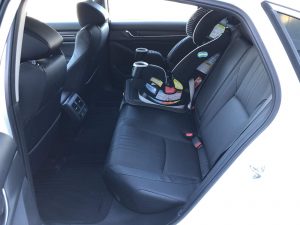
To be fair, EX (and EX-L and Touring) trims also comes with other upgrades – including a larger 8 inch touchscreen, HondaLink smartphone integration, heated rear seats (Touring) and a sunroof.
But it’d be nice if Honda let buyers upgrade just the stereo – for less than $3,900 (the price difference between the base $25,470 trim and the $29,370 EX).
On the upside, you could easily upgrade the base trim’s stereo yourself – for much less than $3,900.
The Rest
An interesting thing to know about the Accord hybrid vs. the Camry hybrid is that all Accord hybrids get the same great gas mileage while only the base trim Camry hybrid gets the best-case/advertised mileage of 51 city, 53 highway.
Because the base trim Camry has a different battery pack while all Accord hybrids have the same battery pack.
It gets more interesting, too – because all of the Camry hybrid trims except the base trim get worse mileage than any Accord hybrid trim. The difference is significant, too. While the base Camry hybrid’s 51 city, 53 highway is class-best all the higher trims get just 44 city, 47 highway.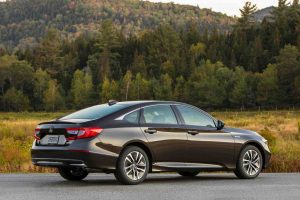
And even though the base trim Camry hybrid’s mileage is better than the base trim Accord hybrid’s mileage, it’s not better enough to make up for the Camry’s $2,780 higher MSRP.
Unless you want a better stereo.
In addition to higher MPGs, the $28,250 to start base trim Camry hybrid comes standard with a six-speaker stereo.
The Bottom Line
With the exception of the stereo upsell, the Accord hybrid sells itself. It’s a deal compared with its hybrid rivals – and it’s less hassle than its electric rivals.
Most of all, it’s not slow.
. . .
Got a question about cars, Libertarian politics – or anything else? Click on the “ask Eric” link and send ’em in!
If you like what you’ve found here please consider supporting EPautos.
We depend on you to keep the wheels turning!
Our donate button is here.
If you prefer not to use PayPal, our mailing address is:
EPautos
721 Hummingbird Lane SE
Copper Hill, VA 24079
PS: Get an EPautos magnet (pictured below) in return for a $20 or more one-time donation or a $10 or more monthly recurring donation. (Please be sure to tell us you want a sticker – and also, provide an address, so we know where to mail the thing!)
My latest eBook is also available for your favorite price – free! Click here. If that fails, email me at [email protected] and I will send you a copy directly!


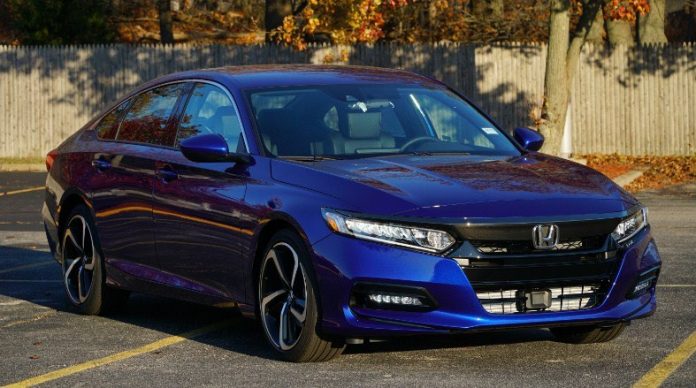


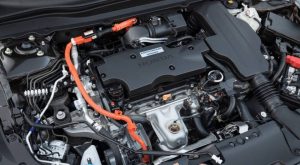
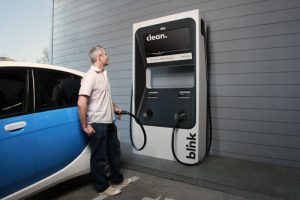
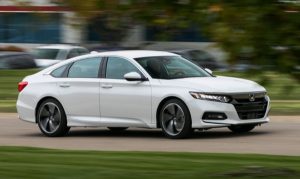
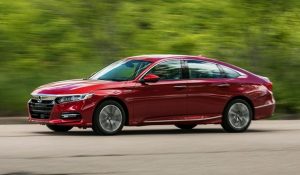








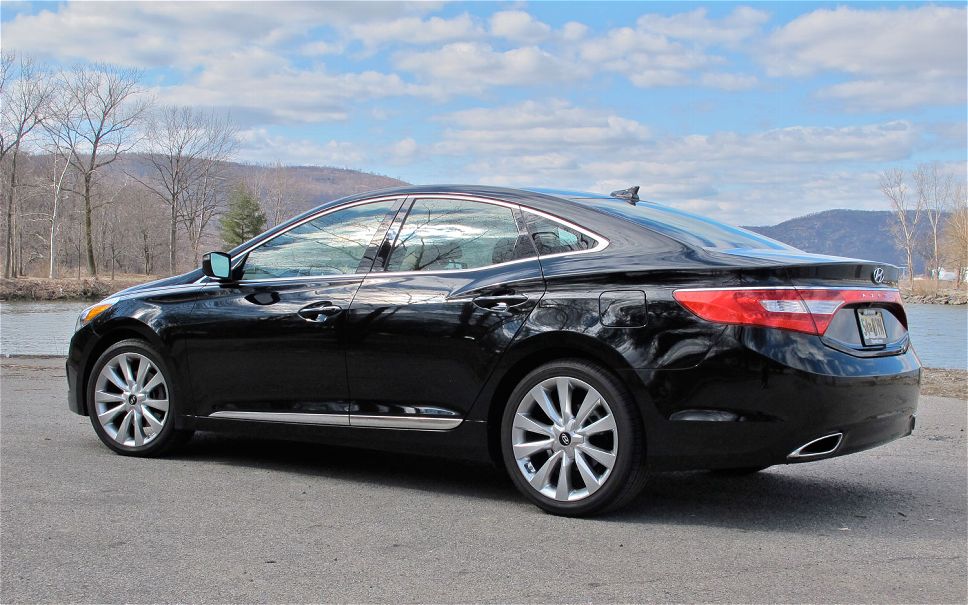
I don’t understand for the life of me why people don’t understand the complexity of these machines. The batteries are expensive, the powertrain management systems needlessly complex and of course the electronic rabble inside is too much to take. This is just another car on the list that I would never buy.
As with my wife’s Camry Hybrid (now our son’s Camry Hybrid), I wonder how long the battery will last and what the replacement cost will be. Of course, the Camry is an 07 and still on the original battery. Has been driven about 75/25 highway/city.
Hi Eric,
Re this: “If you do a lot of stop-and-go driving, the hybrid’s much lower fuel consumption could earn back the $1,690 extra you spent on the hybrid in just a couple of years and after that, the savings could be significant.”
Not as much savings as you might think. In 100,000 miles of driving, the hybrid would use about 2,080 gallons of gas, assuming the 48 MPG rating is fairly accurate. The non-hybrid, assuming a 50/50 mix of city and highway driving for 34 MPGs overall, would use about 2,940 gallons of gas. So, assuming $2.50 per gallon, that’s $2,100 in gas savings, IF you keep the car that long, versus $1,690 extra upfront. But, the hybrid has a hidden cost — those extra batteries. How much do THEY cost to replace when they wear out?
Bottom line — if all you care about is saving money, you might break even overall, if you keep the car long enough to recoup the upfront cost. The correct way of thinking about the hybrid is that it is a big performance upgrade that essentially costs nothing extra if you don’t trade in cars every few years.
“You’ll have to make do with a mediocre four-speaker stereo without AppleCarPlay or Android Auto.”
I was fixing to run down to purchase one but…. No AppleCarPlay! and No Android Auto!
Oh well………. like a sandwich without Miracle Whip.
I think it’s great if I actually have a working AM radio!
Same here, though if the radio cuts out I have my underdash tape player to fall back on.
I know what you’re gonna do now – get that Buck Owens tape out and play it again. 🙂
Kiss, Destroyer. NBL8-7025. King of the Nighttime World split by the track change foil strip…every time I hear it to this day, I expect a blip right near the end of that song. Ahhh, the 70’s!
We had a Moody Blues album with a screw up on Tuesday Afternoon. It was such a good album we continued to play it. It was one of those albums we replaced more than once since albums do wear out.
When we got a good copy and it didn’t do that blip, we’d look up and at each other. Amazing what you come to expect even when it’s a flaw.
Anon, naw, I’m the one who’s going to play that Buck Owens tape but I play the version with Dwight Yoakum doing Streets of Bakersfield.
I once replied to Mama Liberty when she was speaking of living in Bakersfield “Hey you don’t know me but you don’t like me, you say you care less how I feel. How many of you that sit and judge me, ever walked the streets of Bakersfield.” She protested she hadn’t done it and it was pretty funny. It was hard to believe she had never heard the song.
At least the blip wasn’t on Knights in White Satin. That would have been like stopping Freebird in the middle, not allowed in polite company!
Yep, Buck Owens and Dwight Yoakam, the Bakersfield Sound meets Honky Tonk. Really good stuff, better than that freeze-dried, extruded from a can, synthapitched stuff oozing from Nashville nowadays.
At least the blip wasn’t on Knights in White Satin. That would have been like stopping Freebird in the middle, not allowed in polite company!
Yep, Buck Owens and Dwight Yoakam, the Bakersfield Sound meets Honky Tonk and Tejano. Really good stuff, better than that freeze-dried, extruded from a can, synthapitched stuff oozing from Nashville nowadays.
Strange, the website posted an earlier draft along with the final version…apologies!
No shit Crusty. Imagine wired into Freebird or cruising in Knights in White Satin and having that mis-step. That could cause a fight right in the middle of something similar but lots more fun.
Here’s a pretty good version. Be better if it hadn’t gotten unsynchronized. It didn’t used to be.
https://youtu.be/t5P6zdlPJ34?list=RDt5P6zdlPJ34
I raise my glass of Evan to you 8man. Thanks. And, in reply…
https://www.youtube.com/watch?v=EPStDrutPT4
Doug Kershaw Jolie Blon’. Aieee!
You can hear how Country influenced the “Frenchmen south of Alexander” (as my uncles would say), and vice versa be it noted.
Crusty, mighty good and I raise my glass of Evan white, my usual.
Speaking of drinking one day at work and everybody had a different way. They asked me how I drank. Neat….I hope. Get to 100 proof and all you can do is screw it up with something else.
In my early 20’s I was hauling oilfield “stuff”. You never knew what except I liked heavy hauling, specialized loads. Easy to find some bourbon every evening.
I got into a pipe yard down between Lake Charles and Shreveport with a bunch of other guys I’d never seen but had the same logo on their trucks.
They were loading there for the same destination as I. They introduced themselves and then said “I guess you could call us coon-asses”. I was ignorant of what it mean to that point.
Damn, those were good ol boys and we always had some good grub from terminal to terminal we’d fix in the driver’s lounge.
They always had blood sausage and some Beaudreaux mix of some sort. I became acquainted with Zydeco, right down my alley. We sucked heads and ate tails all over the south. Still love them mudbugs.
I’m dyed in the wool enough I listen to Buckwheat Zydeco(buckwheat Beaudreax be good too).
One of the best times I ever had was with Wayne Toups and the Zydecajuns at the Paramount theatre in Abilene, Tx.
https://youtu.be/EBjomuRK9Bo
I likes the Tupelo Honey.
I don’t know why you don’t get a Merle Haggard tape … 😉
The CD’s last longer.
Red Simpson probably never heard of one 😉
Roll Truck Roll said Red.
Hello, I’m a Truck
Jerry Jeff Walker, Viva Terlingua!
Crusty, nothin but hits.
I wonder if anyone will ever build a RWD hybrid of this sort. If I’m to give up my manual transmission one day, I would still love to get the back end out a bit from time to time.
Hi Eric, I’m commenting because you seem to think that some people have a home charger that is capable of providing a near-full charge in 30-45 minutes. That’s not so. Chargers with that level of performance require 480 volt 3-phase power, which is industrial-grade electrical service and is not available in any sort of normal home.
“Fast” home chargers use 240 volt single-phase power (standard in homes, although a dedicated circuit is required for the charger). These provide 7kW at best, enough for about 20 miles of driving range per hour of charge time (again, at best). A full overnight charge, or more, is required to restore a near-depleted EV battery.
“Slow” home chargers use regular 120 volt home power. These provide 1.5kW at best, enough for 4-5 miles of driving range per hour of charge. An all-night charge will restore the battery of a plug-in hybrid, but it would take multiple days to charge the depleted battery of a full EV.
There is lots of info about this on the web. A really simple source is https://www.driveelectricvt.com/charging-stations/types-of-charging
Noting to do with you Steve but some of the Advantages listed at the link are laughably idiotic.
Under 3 DC Fast Charging
“DC fast charging provides compatible vehicles with an 80% charge in 30-60 minutes by converting high voltage AC power to DC power for direct storage in EV batteries………
*Charge time is reduced drastically–it’s nearly as fast as refueling a gasoline vehicle*
Yeah, sure. Nearly as fast being 6 to 12 times as long for only 80% full tank.
Agree about the idiocy. I chose a “Yay, Electric Cars!” site because their pro-EV bias ensures that their numbers are the most optimistic possible. And even those optimistic numbers are pretty gloomy.
Morning Eric,
My “new” 2013 Volt seems better and better every time I compare it to a conventional hybrid. While in Texas, I traded in my wife’s 2012 Pious (a soulless and annoying car) for the Volt. Pious was in pretty poor condition as my wife wouldn’t make the effort to drive/park it well and kept hitting things, usually the support beam of the carport. Luckily for me, most people don’t seem to understand why the Volt is a better car thus I was able to trade in a beat 2012 Pious, plus $1000.00, for a near pristine 2013 Volt. Rapid depreciation sucks for the new car buyer but it does make the over priced Volt a good deal when used.
Mileage for the trip back to SF was not great by hybrid standards (33.5) but I did set the cruise at 80 MPH and SF is over 6500 feet higher than Dallas. The last time I did that return trip in the Pious, I only averaged 37 MPG, not enough difference to care about. Since getting back, the Volt has averaged over 270 MPG and will likely average much more than that (a feat impossible in any other hybrid). I’ve only used 0.1 gallons since my return. Plugging it in is really easy and I know it will fully charge over night because it did so the night of my return. Also, even though it’s been very cold, the stated range matches what I’m getting. As an added bonus, it’s a lot more fun to drive than the Pious.
Maybe I’m missing something, but this approach to a “green” car (I’m not endorsing climate cult hysteria, just noting that appearing to be “green” is important to many), seems so obviously superior to any other hybrid or EV. I realize some are so brainwashed that they only want a “pure” EV, which the Volt is if not driven beyond it’s range but, why has the seemingly inferior hybrid technology of Toyota/Honda/Ford succeeded while the Chevy’s has not? Got any thoughts?
Cheers,
Jeremy
GM will f*** up a cup of coffee!
It used to be the only thing I knew about the Volt was that it was “Obama’s car”. That was negative to me, anyway. Really the only positive things I’ve read about the Volt have been here.
Here in PA the average price for regular unleaded gas is around $2.75 a gallon thanks to the highest state gas tax in the country. Also, premium unleaded is .60 per gallon more than regular, just about everywhere in PA. The hybrid option looks pretty good if you wand to save money on your monthly gas bill.
Hi Spitfire,
I agree – especially in this case. The price to start is only about $1,600 more than the base trim non-hybrid; over a six year loan, it’s probably a $10 per month difference – if that.
But it doesn’t cost you speed – and that is an everyday expense that comes standard with the Prius!
Remember the Honda CR-Z? It was a sub-Civic sized hybrid, with styling very much like the hallowed CRX. It looked great and handled well, but was really slow. However with this hybrid package from the Accord …..that Z would be a “perfect” little sports coupe.
For sure. I drove a CR-Z as a loaner from the dealer. It was a 2016 model, I think. It was a complete dog, but I got 40 mpg in city driving. It went down to about 33-35 when I cranked the car well above 80 mph. Top speed was 107 mph. It was a good handler, but needed a bigger engine for sure. If I could come by one for about 5k, I would buy it for a work car
Or the Geo Metro/Chevy Sprint? 3 cylinders, dog slow, but crazy good fuel economy. The saaaaafety regulations killed it off, not beefy enough to withstand a 16 ton weight crashing down on it per AvtoStasi requirements!
I knew a kid that schlepping pizza with an ’89 Geo Metro with the 3-banger and stick…he put a “test pipe” to bypass the converter and got 55 mpg as he brought folks their Round Table Pizza. That car was noisy and not terribly comfortable, but it was CHEAP to operate!
Eric. These engine compartments are becoming more and more cramped. So much a hand wont be able to fit in there anymore. I am also assuming Average Joe cannot wrench on this thing, as efficient and fuel sippy as it is. But look at how little crumple space there is. Older cars have farther spaced out engine parts and components under the hood. Giving a slighter chance of a frontal accident only destroying the bumper, grill and radiator. I look at this new Honda Hybrid and think that any intrusion into the engine bay front or side is game over TOTALED. I don’t look at too many cars these days so I don’t know if other cars have this problem or just this one. I also can tell you the same problem exists for the 2020 GM trucks too, near zero free space. I changed my oil pressure sensor on my Silverado recently and I sat IN the engine bay to do it. One foot on top of the strut and my rear on the side of truck.
You’re right, Brazos!
I will take a video to show this in more detail. And it’s become very common.